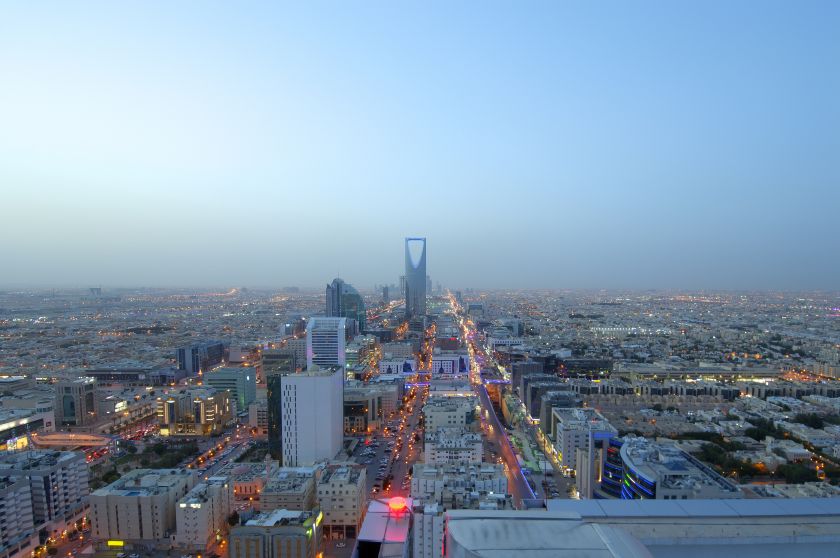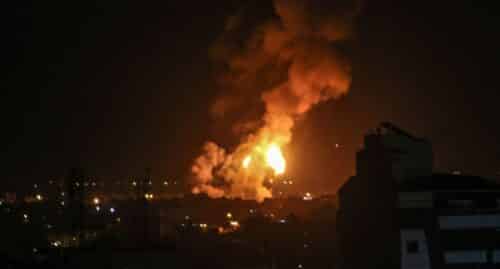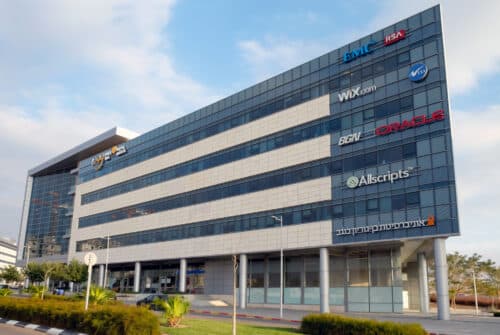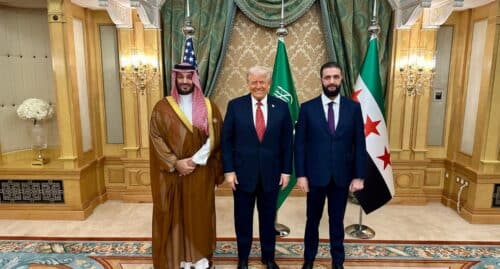
Velvet carpets, exquisite state dinners, Arabian horses and Cybertrucks motorcades – it is impossible to overstate the over-the-top display of opulence and luxury that flanks President Trump at every step of his trip to the region. As in his first term, Trump gave the Saudis and the Gulf states the honor of his inaugural overseas trip. In return, they lavished him with royal gestures, grandeur, and cash – securing eye-popping landmark contracts totaling potentially over $3 trillion.
This breathtaking extravaganza did little to gaslight a broad range of critics, though. Some on the left expressed concern about these deepening economic ties between the US and countries with a checkered human rights record, and raised eyebrows at the 747-plane offered as a gift by Qatar; some on the right reminded the President of the Saudis’ involvement in the 9/11 attacks and Doha’s less-than-ideal ties to terrorism. On the Israel front, however, many rushed to conclude that the President has snubbed Israel in favor of a love affair with some of its rogue neighbors, especially those who harbored Hamas’ leadership and harshly condemned Israel over the course of this war.
The truth, however, transcends all of these concerns. Trump executed an impressive acrobatic feat from his foreign policy playbook with flawless precision. His philosophy came to full display during this trip: strong economic ties, rather than diplomatic pleasantries, as a prescription for forging political and security alliances. Investing in Ukraine’s rare-earth minerals is therefore akin to investing in Saudi Arabia’s energy solutions, Qatar’s counter-drone capabilities, and the UAE’s AI data centers: both serve to entrench American presence and dominance in the region. For Trump, business removes barriers.
When Trump called the region to embrace “commerce, not chaos” and export “technology, not terrorism”, he appealed to this same sentiment: a region redefined by younger leaders who wish to leave past differences behind and develop significant economic powerhouses comfortably cushioned under the auspices of a strong American umbrella. Trump’s background as a real-estate mogul was particularly highlighted as he praised the “majestic skyscrapers”, called to “build cities together”, awed the Sheik Zayed Grand Mosque and even complimented the Qatari palace’s “perfect marble”.
Such utilitarian pragmatism, however, should be taken with a grain, rather a pile of salt in a region rife with ideological fault lines. If Trump expects the former HTS jihadist or the terror sponsors in Doha to somehow neglect their radical aspirations for the prospect of economic prosperity, then he’s in for an overly optimistic illusion that could undermine American interests. Iran has also opened its markets to the world following the Nuclear Deal in 2015, only to use the money for the nuclear program and the IRGC; and Qatar weaponizes its blood money for Hamas, ISIS, and radicalizing the American youth in prestigious universities. However, Trump shows no signs of ignoring these realities – on the contrary, he complements his optimism with waving a big stick.
This change of tune does not imply a change of tone: Trump is far from losing sight of his strategic geopolitical objectives; on the contrary, he doubled down on them. Regarding Iran, Israel’s foremost concern and a regime that poses a real threat to the US and global security – Trump did not disappoint. In his remarks in Riyadh, Trump mentioned Iran no less than 19 times, accusing it of funding “terror and death all over the world” and no less than the “most destructive force” in the region, focusing heavily on its part in wrecking Syria. His remarks triggered an angry response in Tehran.
Crucially, he underscored that the regime “cannot have a nuclear weapon”. Trump said as usual that he would be “happy to make a deal”, and hinted that such a deal could be coming soon, but paired the offer with an equally clear threat, warning that there is no time to wait. During his visit in 2022, then-President Biden simply demanded Iran to go back to its vague commitments under the problematic 2015 Nuclear Deal.
Regarding Gaza, a host of false reporting in the Arab media led some to believe that Trump will somehow throw Israel under the bus or force its hand into capitulating in Gaza or accept a Palestinian state. Yet the war was barely mentioned in the trip, to the point where pro-Palestinian advocates accused the President of forgetting Gaza and pushing it on to the sidelines of US diplomacy. While in Qatar, Hamas’ top sponsor, Trump reiterated his plan to take administrative control over Gaza, making it a “freedom zone”, and advanced his plan to relocate Gazans.
Finally, Trump called upon “all civilized people” to condemn October 7, demanded the release of all hostages, and conditioned Gaza’s bright future on stopping to “kidnap, torture, and target innocent men, women, and children for political ends” – there, in the heart of the Arab peninsula, in front of hundreds of Arab leaders.
Not only did Trump not turn his back on Israel, on the contrary – he used the occasion to advance his vision for the new regional security architecture, one that perfectly aligns with that of Israel: he urged Saudi Arabia to join the Abraham Accords with Israel, forging an American-Arab-Israeli alliance that presents a unified front against Iran. He went a step further by extending the same offer to the once-jihadist Ahmed A-Sharaa, interim president of Syria, shocking the world by removing sanctions, and said he wants to “give them a chance at greatness” and that “it’s their time to shine” – while also urging him to normalize ties with Israel. This could be a bridge too far, but with Trump, surprises are an integral part of routine.
Inasmuch as the trip took place in the Middle East, Trump on his part kept his eye sharp on the far East – and his adversary in Beijing. Over the past decade, China has ramped up its investments in the region, taking advantage of an American disinterest and disengagement from a war-torn Middle East. In 2022, China’s total bilateral good trade volume with the region reached $368.4 billion, more than double than the US’s $144 billion. America cannot play second fiddle to China, and Trump is leaving the region with pockets full of cash and an avalanche of companies signing deals, much to Beijing’s dismay.
Trump articulates a purely pragmatic, common-sense mercantilism that aligns with his utilitarian worldview – embracing prescriptions that work, rejecting premises that fail, and giving a chance for money to speak.
His optimism and economic investment are far from being reminiscent of those of the European Union, in comparison. The EU has long embraced economic power and cultural allure as tenets of foreign policy, yet failed to deliver pragmatism, project military power, or sustain reliable economic infrastructure, with untold debt, painfully slow growth, and crippling regulations. Trump complemented his optimism with the clear commitment of a superpower, and an unprecedented $1 trillion defense budget.
Trump’s worldview is no big mystery, but this trip highlighted it in bright letters. He offered a “strong and steady hand” to the Saudi crown prince and spoke with American troops under the banner “peace through strength”. He exhibited American leadership against the backdrop of those who still believe he is based on isolationism. The President offered a golden tray of opportunity, dreaming of “the dawn of the bright new day that awaits for the people of the Middle East” and giving rogue regimes the chance to “shine”. But unlike appeasing leaders in the past who made promises of a “new Middle East”, Trump carries the cadence of command, and comes with demands.
This renewed American footprint in the region will alienate China, pull Arab countries to the US orbit, cement the unified front against Iran, and design the security architecture that Israel has been advocating for. If he succeeds in making good on his promise to deny Iran of nuclear weapons, cut a peace deal between Israel and Saudi Arabia with no significant perks to the Palestinians, and fundamentally change the security reality in Gaza, he will go down in history as the President who reshaped Israel’s strategic posture in the region. Time will tell.
This article was originally published in Jewish News Syndicate (jns).
The views expressed in this article are those of the author and do not necessarily represent the views of the movement




